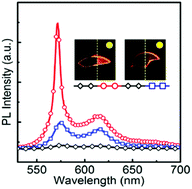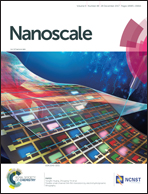Surface plasmon-enhanced amplified spontaneous emission from organic single crystals by integrating graphene/copper nanoparticle hybrid nanostructures†
Abstract
Organic single crystals have attracted great attention because of their advantages such as high carrier mobility and high thermal stability. Amplified spontaneous emission (ASE) is an important parameter for the optoelectronic applications of organic single crystals. Here, surface plasmon-enhanced ASE from the organic single crystals has been demonstrated by integrating graphene/copper nanoparticle (Cu NP) hybrid nanostructures. Graphene is fully accommodating to the topography of Cu NPs by the transfer-free as-grown method for the configuration of the hybrid nanostructures, which makes full electrical contact and strong interactions between graphene and the local electric field of surface plasmon resonances. The enhanced localized surface plasmon resonances induced by the hybrid nanostructures result in an enhanced intensity and lowered threshold of ASE from the organic single crystals. Moreover, the as-grown graphene sheets covering fully and uniformly on the Cu NPs act as a barrier against oxidation, and results in an enhanced stability of the fluorescence from the crystals.



 Please wait while we load your content...
Please wait while we load your content...